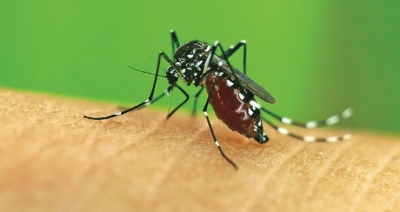Zika Virus Outbreak

By Brianne McCurley
Are you primed and ready for a break from the winter weather? If you are looking to get away to a tropical destination, you might want to think twice about traveling to the Caribbean or South America. The recent outbreak of the Zika virus in 29 countries has travelers and world health officials on alert.
The Aedes species mosquito – found on all continents except Antarctica — is responsible for transmission of Zika. This species of mosquito is responsible for many viruses including dengue, yellow fever, Zika and chikungunya. The most common symptoms of the Zika virus are fever, rash, joint pain and conjunctivitis (pink eye). The illness is typically mild and lasts several days to one week. Severe reactions requiring hospitalization are uncommon and death is rare. According to CNN’s Chief Medical Correspondent, Dr. Sanjay Gupta, “the vast majority of people, approximately 80%, who get this infection will experience little or no symptoms.” People who have suppressed immune systems and other infectious diseases may experience additional complications if infected with the Zika virus. At the time of publication, three deaths have been reported, but it is still undetermined if there is a direct link between the deaths and Zika.
Treatment
There is no vaccine or medications available to treat Zika infections. However, it can be treated by getting plenty of rest and drinking a lot of fluids. Pharmaceutical companies are scrambling to develop a vaccine, but trials could still be more than one year away, according to the Associated Press. The Department of Homeland Security is working closely with the U.S. Centers for Disease Control and Prevention (CDC) to monitor the disease. They are working to educate people on the signs and symptoms, as well as monitoring infected travelers at the border and at detention facilities.
Birth Defect Concern
In Brazil, it was initially reported that the virus is associated with the birth defect microcephaly. Since November 2015, Brazil has reported more than 4,000 suspected cases of microcephaly; however, the numbers may not in fact be microcephaly or linked to Zika. The country initially asked doctors to report all babies with a head circumference of 33 centimeters or less, but that is not a reliable factor. If that measurement was used, according to United States growth charts 10 percent of American newborns would fall into the suspected microcephaly category. That is obviously too high of a percentage. The CDC defines microcephaly as a birth defect where a baby’s head is smaller than expected when compared to babies of the same sex and age. It can lead to developmental delays and impaired motor skills. This condition can also be caused by genetic factors and drug and alcohol use during pregnancy. However, knowledge of the link between Zika and microcephaly are still being researched.
A group of Argentine physicians have recently challenged the alleged link. They suspect that the cause for the rise in microcephaly cases is not the Zika virus but the introduction of a toxic larvae, Monsanto Larvicide, in the water supply. The chemical Larvicide was injected into Brazil’s water supply in 2014 to halt the development of mosquito larvae in drinking water tanks. The chemical, pyriproxyfen, is manufactured by Sumimoto Chemical, a Japanese subsidiary of Monsanto. Thousands of children have been born with malformations from pregnant women living in these areas where pyriproxyfen was injected into the water supply.
At the time of publication, the Zika virus had spread to 29 countries since the current outbreak started. Zika is in the United States, but only from travelers returning from an infected area. It is likely that the spread of the disease will not be as devastating in the U.S. as it is in Caribbean and South American countries because of the cooler climate. Mosquitoes need hot weather to reproduce. People should use caution when traveling to the affected countries. If you are traveling abroad for an upcoming vacation or business trip, it is recommended to use insect repellent with DEET, wear long-sleeve shirts and long pants, stay in air-conditioned rooms and avoid areas with standing water, where mosquitos can breed.
Mosquito Facts
- Mosquitoes are the deadliest animal in the world.
- They kill about 725,000 people every year. That’s more than sharks, wolves, lions, crocodiles and snakes combined.
- Malaria is the deadliest disease carried by mosquitoes, killing more than 400,000 people every year.
- There are more than 3,000 species of mosquitoes.
- They live on every continent, except Antarctica.
- Some mosquitoes become immune to DEET after only three hours of exposure to the repellent.
Symptoms of Zika Virus
- Fever
- Rash
- Joint Pain
- Pink Eye (Conjunctivitis)
EDITOR'S NOTE
The information contained in this article was current as of publication deadlines. Information on this outbreak is changing rapidly. Visit www.headlinesciencenow.com for the most up-to-date information.
Classroom Discussion
- What other viruses are transmitted by mosquitoes?
- Can you think of any other cases where chemicals were injected into the drinking water and caused health problems?
Vocabulary
- Larvae
- Chikungunya
- Yellow fever
- Dengue
